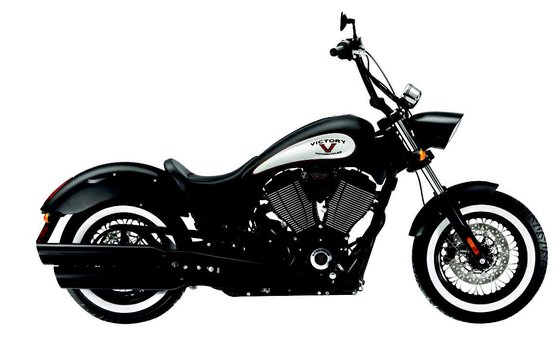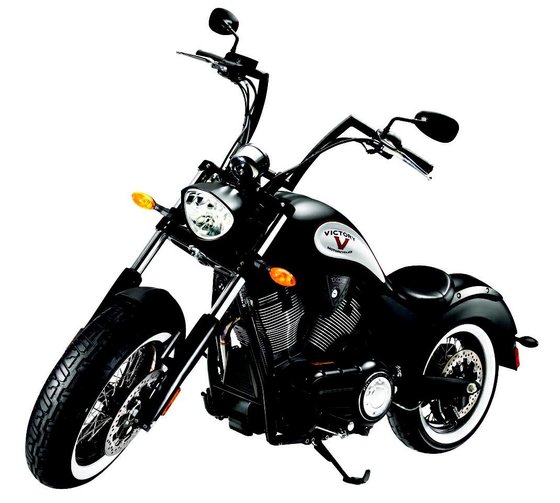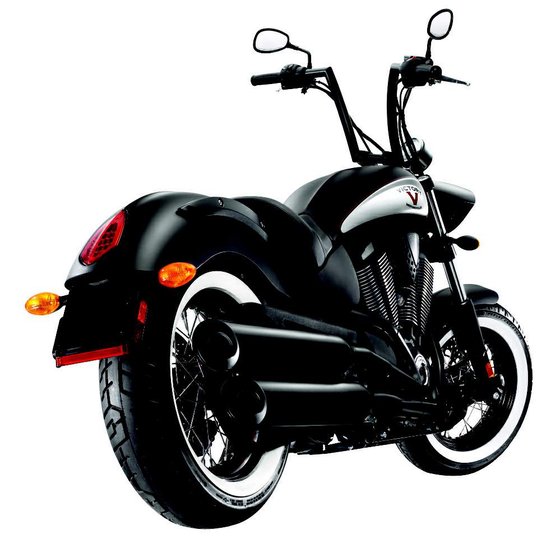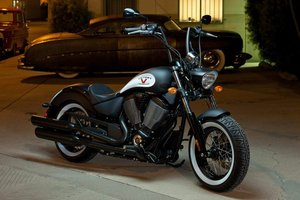The Victory High-Ball [2012-2017]: A Bobber with Bite

When Victory Motorcycles unleashed the High-Ball between 2012 and 2017, it wasn’t just launching another cruiser—it was making a statement. This machine embodies the essence of a modern bobber: stripped-down aesthetics, brute-force power, and a rebellious attitude that refuses to blend into the background. After spending time with this blacked-out beast, it’s clear the High-Ball wasn’t designed for compromise. It’s a motorcycle that demands attention, both from its rider and anyone lucky enough to witness it roar past.
Design: Less Is More, But Better

The High-Ball’s design philosophy is pure bobber minimalism. From its chopped front fender to the solo saddle and matte-black everything, this bike looks like it rolled straight out of a garage where “unnecessary” is a dirty word. The 16-inch spoked wheels wrapped in chunky whitewall tires (Dunlop Cruisemax or Metzeler ME880, depending on the year) are a masterstroke—nostalgic yet bold. Victory’s blackout treatment extends to the exhaust, engine covers, and even the handlebars, creating a cohesive “night rider” aesthetic.
The adjustable ape hangers deserve special mention. At their highest setting, they force you into a laid-back, arms-up posture that screams confidence. But Victory cleverly designed them to be rotated downward for a more relaxed stance—no rewiring required. It’s a nod to customization without the hassle, though most riders will likely keep them sky-high for maximum swagger.
Engine & Performance: Torque Is the Name of the Game

At the heart of the High-Ball lies the Freedom 106/6 V-Twin—a 1,737cc (106 cubic-inch) powerhouse that’s anything but subtle. With 97 hp and a stump-pulling 113 ft-lbs (153 Nm) of torque, this air/oil-cooled engine isn’t just powerful—it’s urgent. Throttle response is immediate, and the surge of torque from as low as 2,000 RPM makes stoplight drags embarrassingly easy.
The 6-speed transmission shifts with a satisfying mechanical click, and the overdrive 6th gear is a blessing on highways, keeping RPMs at a relaxed 2,500 at 70 mph (113 km/h). The carbon fiber-reinforced belt drive is virtually maintenance-free, transferring power smoothly without the clunkiness of a chain.
But this engine isn’t just about brute force. Hydraulic lifters and self-adjusting cam chains mean no valve adjustments—a small mercy for owners who’d rather ride than wrench.
Handling: Surprisingly Nimble for a Bruiser
With a shorter wheelbase (64.8 inches/1,646 mm) and aggressive 32° rake, the High-Ball defies the “lazy cruiser” stereotype. The steering is quicker than you’d expect, aided by a substantial 6.7 inches (170 mm) of trail that adds stability. In city traffic, the bike feels flickable, and the wide handlebars provide leverage for tight U-turns.
The suspension—43mm telescopic forks up front and a preload-adjustable mono-shock out back—is firm but not punishing. It soaks up potholes better than most hardtail bobbers, though the limited 3 inches (75 mm) of rear travel reminds you this isn’t a touring bike. Ground clearance is modest at 4.7 inches (119 mm), so aggressive cornering will scrape the pegs early.
Braking is handled by dual 300mm front discs with 4-piston calipers and a single rear disc. ABS (available on later models) adds confidence in wet conditions, though purists might lament its inclusion.
Comfort: Built for Short Bursts, Not Marathons
The 25-inch (635 mm) seat height makes the High-Ball accessible, but the solo saddle is a lesson in austerity. After an hour, you’ll be shifting weight constantly—a fair trade for the bike’s stripped-down ethos. Vibrations are minimal thanks to the counterbalanced engine, but windblast at highway speeds is significant. This isn’t a bike for cross-country trips; it’s for carving up city streets and short backroad blasts.
Fuel capacity is 4.5 gallons (17 liters), which, combined with an average 35 mpg (6.7 L/100 km), translates to a 150-mile (240 km) range. The analog speedo/tach combo is legible, but the lack of a fuel gauge (only a warning light) keeps things “old-school.”
Competition: How Does It Stack Up?
The High-Ball’s closest rival was the Harley-Davidson Cross Bones, a springer-forked homage to post-war bobbers. While the Harley oozes heritage, the Victory fights back with 13% more torque and a lower seat height. The Cross Bones’ suspension (a genuine springer front and hidden rear shocks) is plusher, but the High-Ball’s modern chassis offers sharper handling.
Another contender was the Indian Scout Bobber, which arrived later but targeted the same “factory custom” crowd. The Scout is lighter and revvier, but the High-Ball’s V-Twin delivers torque earlier, making it feel brawnier in real-world riding.
Where the Victory truly shines is its value proposition. Compared to its peers, it offered more power and customization potential straight from the factory, without the premium price tag of a boutique build.
Maintenance: Keeping the Beast Alive
Owning a High-Ball is relatively straightforward, but a few key areas demand attention:
-
Oil Changes: The 4.7-liter sump requires synthetic 20W-50 oil every 5,000 miles (8,000 km). Consider upgrading to a high-flow oil filter for better cooling.
-
Belt Drive: Inspect the carbon fiber belt for debris and tension every 10,000 miles (16,000 km). Replacement is rare but straightforward.
-
Brakes: The stock pads can wear quickly under aggressive riding. Swap in sintered pads for improved bite and longevity.
-
Electronics: The battery (YTX20HL-BS) is robust, but keep terminals clean—corrosion is common in humid climates.
-
Customization: The High-Ball shares parts with other Victory Vegas models. At MOTOPARTS.store, we recommend:
- Vance & Hines 2-into-1 exhaust: Unlocks deeper exhaust notes and minor performance gains.
- Corbin Solo Seat: Adds much-needed comfort without ruining the bobber look.
- LED Turn Signals: Modernize the lighting while maintaining the minimalist aesthetic.
Final Verdict: A Modern Classic
The Victory High-Ball is a rare beast—a factory-built bobber that doesn’t neuter performance for style. Its torquey engine, aggressive stance, and endless customization potential make it a favorite for riders who want to stand out without sacrificing reliability. While Victory’s demise in 2017 adds a layer of exclusivity, parts support remains strong through vendors like MOTOPARTS.store.
This isn’t a motorcycle for everyone. It’s loud, unapologetic, and demands a certain level of mechanical sympathy. But for those who get it, the High-Ball isn’t just a bike—it’s a middle finger to conformity, wrapped in black steel and whitewall rubber.


















